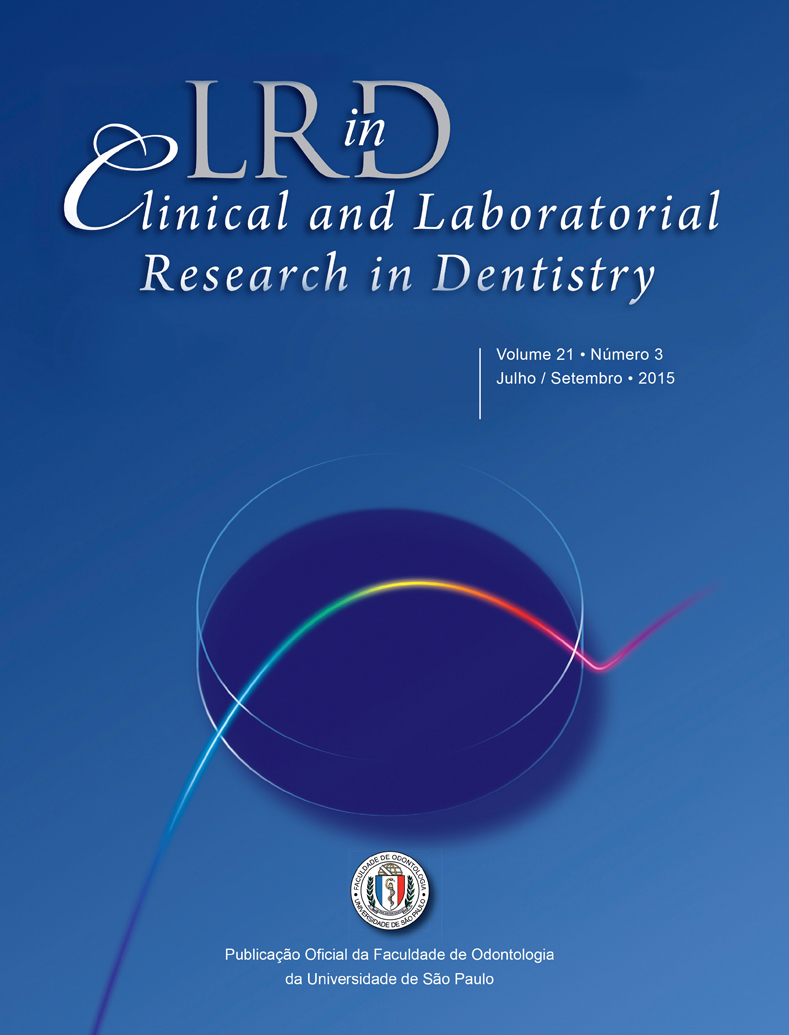Influência das características das fibras na resistência flexural e modo de fratura dos pinos intrarradicualres
DOI:
https://doi.org/10.11606/issn.2357-8041.clrd.2015.121347Keywords:
Pino de fibra de vidro, Resistência Flexural, Fibras, Propriedades.Abstract
Objetivo: O objetivo do presente estudo foi avaliar a influência das características das fibras na resistência flexural e modo de fratura dos pinos. Material e Métodos: Foram selecionados pinos de fibra de vidro de diferentes marcas comerciais: Exacto, Reforpost RX, White Post DC e Superpost Glass. Os pinos foram submetidos ao teste de resistência flexural. Foi calculada a resistência flexural e o módulo de elasticidade. A microscopia eletrônica de varredura acessou o modo de fratura, fração de volume de fibras, diâmetro das fibras, presença de bolhas e falhas. A ANOVA comparou o efeito dos diâmetros das fibras na resistência flexural. O teste de Tukey determinou as diferenças dos valores de resistência flexural. O teste de múltiplas comparações de Games Howell analisou os diâmetros das fibras. O teste de Pearson estabeleceu correlações entre resistência flexural e diâmetros dos pinos. Resultados: A resistência flexural foi de 445,43 GPa para o White Post DC a 719,22 GPa para o Reforpost RX. O módulo de elasticidade variou de 6,39 GPa para o White Post DC a 23,33 GPa para o Exacto. Foram encontradas diferenças entre os diâmetros das fibras exceto entre White Post DC e Superpost Glass. Pinos lisos apresentaram fratura longitudinal e serrilhados transversal. Conclusão: Maiores diâmetros das fibras, elevaram a resistência flexural. Pinos de maiores diâmetros demonstraram maiores valores de módulo de elasticidade. O filamento metálico gerou elevação do módulo de elasticidade. Alterações abruptas no diâmetro dos pinos causam enfraquecimento e redução das propriedades mecânicas. Bolhas foram observadas em todos os pinos.
Downloads
Downloads
Published
Issue
Section
License
Authors are requested to send, together with the letter to the Editors, a term of responsibility. Thus, the works submitted for appreciation for publication must be accompanied by a document containing the signature of each of the authors, the model of which is presented as follows:
I/We, _________________________, author(s) of the work entitled_______________, now submitted for the appreciation of Clinical and Laboratorial Research in Dentistry, agree that the authors retain copyright and grant the journal right of first publication with the work simultaneously licensed under a Creative Commons Attribution License that allows others to share the work with an acknowledgement of the work's authorship and initial publication in this journal. Authors are able to enter into separate, additional contractual arrangements for the non-exclusive distribution of the journal's published version of the work (e.g., post it to an institutional repository or publish it in a book), with an acknowledgement of its initial publication in this journal. Authors are permitted and encouraged to post their work online (e.g., in institutional repositories or on their website) prior to and during the submission process, as it can lead to productive exchanges, as well as earlier and greater citation of published work (See The Effect of Open Access).
Date: ____/____/____Signature(s): _______________


